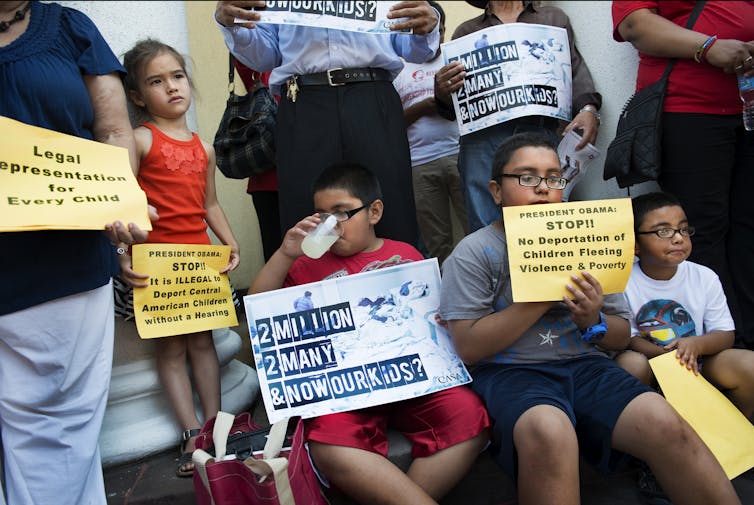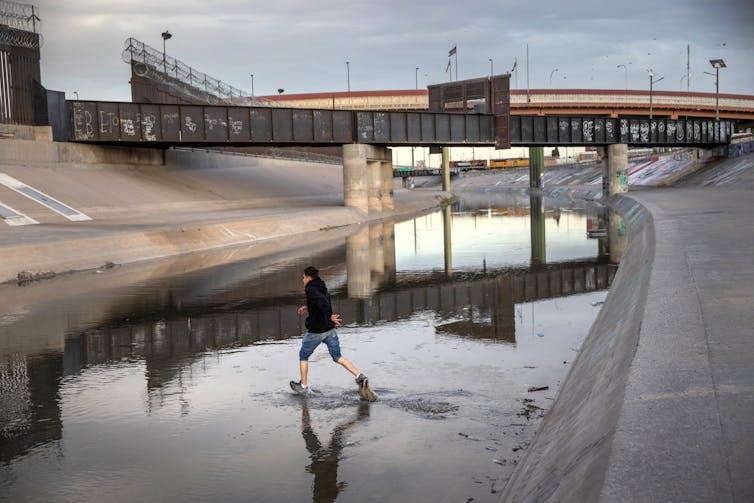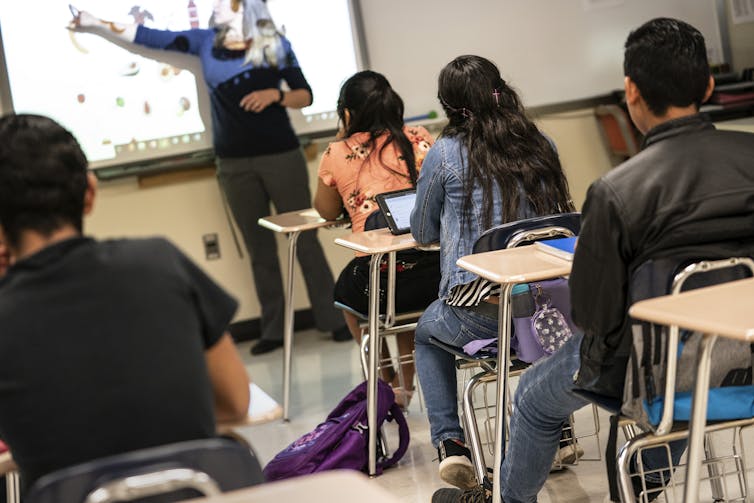4 reasons why migrant children arriving alone to the US create a 'border crisis'
- Written by Ediberto Román, Professor of Law, Florida International University
Children arriving at the southern border without their parents have presented a political and humanitarian challenge for the past three presidents.
Their numbers began rising considerably after 2009, when 19,418 children were taken into custody at the border[1], according to U.S. Customs and Border Protection. Unaccompanied minors peaked in 2014, with 68,000 apprehensions. Analysts say 2021 is on pace to break that record[2], with more than 600 children arriving daily[3] to the U.S.-Mexico border. Most are teenagers seeking asylum.
Reports of children in warehouses or jaillike facilities have set President Joe Biden on the defensive about what critics refer to as a “crisis at the border[4].” In his first press conference, on March 25, 2021, Biden repeatedly stressed that his practice[5] is different from that of former President Donald Trump, who introduced a policy of separating migrant children from their parents and detaining them in cages[6].
“We are not talking about people ripping babies from mothers’ arms,” Biden said.
He said his administration[7] is “moving rapidly … to get these kids of out of the border patrol facilities.”
Child migration has long been such a vexing, bipartisan quandary for four primary reasons, based on my research as an immigration scholar[8] and analysis in dozens of law review articles[9].
 Children protest President Obama’s immigration policies in Washington, D.C., in 2014.
Linda Davidson / The Washington Post via Getty Images[10]
Children protest President Obama’s immigration policies in Washington, D.C., in 2014.
Linda Davidson / The Washington Post via Getty Images[10]
1. Children need care
Migrant children cannot simply get jobs and fend for themselves upon arrival to the U.S. They need to be housed, educated and fed. While some may have family with them or in the U.S., many do not.
By law the Department of Health and Human Services, or DHHS, must transport unaccompanied children to a facility run by the Office of Refugee Resettlement, a DHHS department, within 72 hours of the children’s being apprehended by Customs and Border Protection[11]. While their legal status as immigrants or asylum-seekers is being resolved[12] – which can take over two years – authorities attempt to connect the children with a parent, family member[13] or family friend in the U.S.
A child who has no known U.S. connections is placed in a licensed shelter or foster home[14] while the asylum application or immigration process proceeds. Nonprofit and for-profit groups operate more than 170 housing facilities in 22 states under grants from the Office of Refugee Resettlement.
The Trump administration slashed federal funding for refugee services[15], forcing many shelters and resettlement offices to close. Biden says his administration is “moving rapidly to try to put in place what [Trump] dismantled.” To address rising child migration and the Trump-era facilities shortage, Biden has ordered another 16,000 beds to house these children[16].
 A teenage migrant crosses from Ciudad Juarez, in Mexico, to California, March 21, 2021.
John Moore/Getty Images[17]
A teenage migrant crosses from Ciudad Juarez, in Mexico, to California, March 21, 2021.
John Moore/Getty Images[17]
2. Care is costly
Unlike the roughly 11 million undocumented adults in the United States – a vital labor force that, studies show, drives key sectors of the U.S. economy like agriculture and construction[18] – undocumented children require economic resources.
In 2014, a House of Representatives subcommittee held a hearing[19] on that year’s record-high child arrivals. As Rep. Raul Labrador of Idaho observed, “The impact has been felt across the country, imposing a variety of costs, such as for education, health care, policing and criminal justice.”
Children also need translators and legal counsel during their immigration proceedings, and they cannot pay these costs. It falls to federal, state and local governments, as well as nonprofit organizations, to provide legal pro bono services. Despite these efforts, an estimated 75% to 90% of children undergo U.S. deportation proceedings without a lawyer to represent them[20], though in practice they are rarely deported[21].
Communities where the children are ultimately placed bear the brunt of youth immigration, receiving hundreds of newcomers or more each year.
“Texas alone received nearly 5,300 children in just a seven-month period at the beginning of this year. Miami-Dade District in Florida reported that it had 300 more students in a single quarter of last year, which costs about $2,000 more per additional student,” Labrador said in 2014.
The federal government provides resources[22] to help cover these costs. But budget planning is difficult, as city officials are not always informed when children are to arrive. DHHS has also faced criticism for not tracking children once they are placed with sponsors[23].
 Migrant children learn English in a class created for new Spanish-speaking arrivals in Worthington, Minnesota, on Sept. 5, 2019.
Courtney Perry/For the Washington Post[24]
Migrant children learn English in a class created for new Spanish-speaking arrivals in Worthington, Minnesota, on Sept. 5, 2019.
Courtney Perry/For the Washington Post[24]
3. Care is complicated
These last two issues combine to create an incentive for policymakers to simply demand these children be returned to their home countries.
But many of these children face violence in their home countries and are thus seeking political asylum. As President Biden suggested during his first press conference[25], sending them home would violate U.S. law, which requires the protection for those who face a well-founded fear of persecution.
The U.S. has human rights obligations under international law[26], too, including a proscription against returning refugees to a country where they would face “cruel, inhuman or degrading treatment, torture or other irreparable harm.”
Following domestic and international law, the U.S. should contact the families of unaccompanied minors to ensure parents are aware that their children are in the U.S. and consent to their residing in the country, perhaps permanently.
But finding these parents, especially in remote areas of Central America, can be difficult[27]. Younger children may know only their parents’ names – not their address or phone number[28]. Sometimes the contact information they have is outdated or incorrect.
4. Migrants are nobody’s constituents
These are all big problems, but the U.S. government has solved big problems before. So why is the country still struggling to effectively deal with the decade-old issue of child migrants?
The primary reason, in my analysis: politics.
Undocumented immigrants – and particularly children – are not the constituents of any Washington politician. They have no voice within the U.S. democratic system. While journalists can and do report on immigration problems[29], and public interest law firms can and do represent these children in immigration proceedings[30], unaccompanied minors are simply not part of any politician’s voting bloc or reelection strategy.
Consequently, the issue is often overlooked or mishandled without real political repercussions. There are public relations costs to a presidential administration’s being perceived as allowing children to suffer. But survey research shows American voters don’t rate immigration high on their priority list[31].
And undocumented immigrants and refugee children themselves cannot really hold politicians accountable for their failures at the border.
References
- ^ 19,418 children were taken into custody at the border (www.usccb.org)
- ^ is on pace to break that record (www.cnn.com)
- ^ more than 600 children arriving daily (www.cnn.com)
- ^ crisis at the border (dojustice.crcna.org)
- ^ repeatedly stressed that his practice (www.usatoday.com)
- ^ detaining them in cages (apnews.com)
- ^ said his administration (www.youtube.com)
- ^ research as an immigration scholar (nyupress.org)
- ^ dozens of law review articles (papers.ssrn.com)
- ^ Linda Davidson / The Washington Post via Getty Images (www.gettyimages.com)
- ^ being apprehended by Customs and Border Protection (www.usccb.org)
- ^ is being resolved (www.cbsnews.com)
- ^ family member (www.acf.hhs.gov)
- ^ in a licensed shelter or foster home (www.migrationpolicy.org)
- ^ slashed federal funding for refugee services (www.theatlantic.com)
- ^ another 16,000 beds to house these children (www.cbsnews.com)
- ^ John Moore/Getty Images (www.gettyimages.com)
- ^ key sectors of the U.S. economy like agriculture and construction (theconversation.com)
- ^ held a hearing (www.govinfo.gov)
- ^ without a lawyer to represent them (www.ncsl.org)
- ^ they are rarely deported (www.cbsnews.com)
- ^ federal government provides resources (www2.ed.gov)
- ^ not tracking children once they are placed with sponsors (www.cfr.org)
- ^ Courtney Perry/For the Washington Post (www.gettyimages.com)
- ^ President Biden suggested during his first press conference (www.independent.co.uk)
- ^ human rights obligations under international law (www.ohchr.org)
- ^ can be difficult (www.nbcnews.com)
- ^ not their address or phone number (www.usatoday.com)
- ^ report on immigration problems (www.foxnews.com)
- ^ represent these children in immigration proceedings (www.americanbar.org)
- ^ immigration high on their priority list (www.pewresearch.org)
Authors: Ediberto Román, Professor of Law, Florida International University

